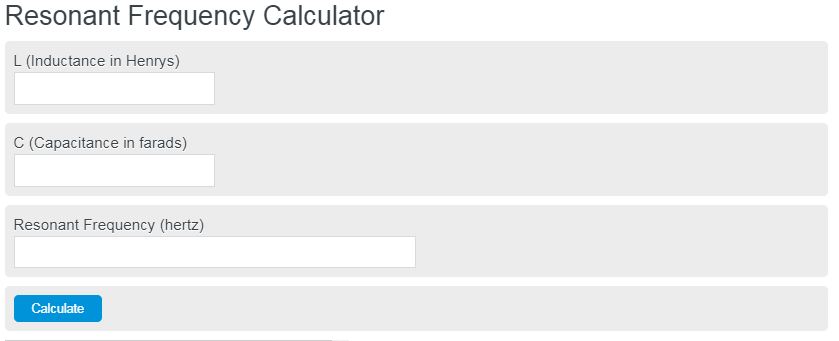Enter the inductance in henrys and capacitance in farads to calculate the resonant frequency of an LC circuit.
- Capacitance Calculator
- Mutual Inductance Calculator
- Phase Difference Calculator
- Natural Frequency Calculator
Resonant Frequency Formula
The following formula is used to calculate a resonant frequency.
f = 1 / 2*pi*sqrt (L*C)
- Where f is the frequency
- L is inductance in Henries
- C is capacitance in farads
Resonant Frequency Definition
Resonant frequency refers to the specific frequency at which an object or system naturally oscillates or vibrates with the greatest amplitude. It is the frequency at which an object responds most strongly to external forces or disturbances. When a system is excited at its resonant frequency, the amplitude of its vibrations increases significantly.
Understanding resonant frequency is crucial in various fields, including physics, engineering, and music, as it helps determine how objects and systems will respond to external forces or vibrations.
By identifying the resonant frequency of a system, engineers can design structures or devices that can withstand or avoid dangerous vibrations. This knowledge is especially vital in fields such as civil engineering, aerospace, and mechanical engineering.
In the field of physics, resonant frequencies play a fundamental role in studying wave phenomena. Resonance occurs when the frequency of an applied external force matches the natural frequency of the system, leading to a phenomenon known as resonance.
This resonance can amplify the vibrations, resulting in large oscillations. Understanding resonant frequencies helps physicists analyze and predict the behavior of waves, whether it’s in acoustics, optics, or electromagnetic waves.
How to calculate resonant frequency?
How to calculate a resonant frequency?
- First, determine the inductance.
Measure or calculate the inductance of the system.
- Next, determine the capacitance.
Measure or calculate the capacitance of the system.
- Finally, calculate the resonant frequency.
Using the formula above, calculate the resonant frequency.
FAQ
What is the significance of calculating the resonant frequency in engineering?
Calculating the resonant frequency is crucial in engineering for designing systems that are either resonant at desired frequencies or avoid resonance at harmful frequencies. This is particularly important in fields like civil engineering, to prevent structural failures during earthquakes, and in electronics, for designing circuits with specific response characteristics.
How does the resonant frequency affect musical instruments?
In musical instruments, the resonant frequency determines the pitch and quality of the sound produced. Instruments are designed to have resonant frequencies that align with musical notes, allowing them to produce clear, harmonious sounds. Adjusting the physical properties of the instrument can change its resonant frequencies, thus altering its sound.
Can the resonant frequency of a system change over time?
Yes, the resonant frequency of a system can change over time due to factors like wear and tear, changes in temperature, or alterations in structural integrity. In engineering and maintenance, monitoring these changes is essential for ensuring the continued safety and performance of structures and devices.
Why is it important to avoid resonance in certain applications?
Avoiding resonance is critical in certain applications because resonance can lead to excessive oscillations that may cause structural damage or failure. For example, bridges, skyscrapers, and airplane parts are designed to avoid resonance with common vibration sources, such as wind or engine vibrations, to ensure their integrity and safety.


For more related calculators, click here.